HP Spectre x2 (2017): A Very Serious Surface Pro Challenger
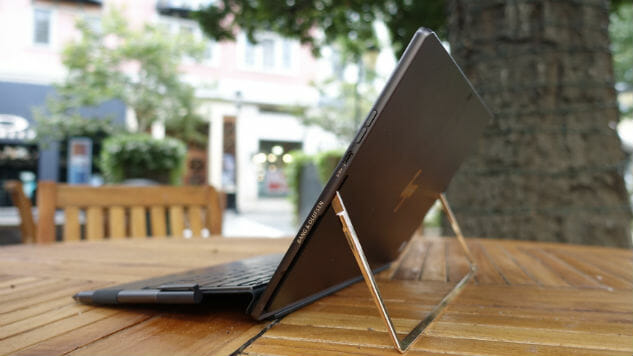
HP masterfully takes the detachable PC form factor and adds its own design touches to give the Spectre x2 its own iconic look. Blending high tech with high fashion—thanks to the Saffiano leather-like keyboard folio (included in the box)—the Spectre x2 blurs the line between modern art and a technology-stuffed PC sitting on your desk.
As a detachable that supports inking capabilities, the Spectre also competes against Lenovo’s Miix 720, Samsung’s Galaxy Book, Huawei’s MateBook E-Series and Apple’s iPad Pro. With its watchband hinge kickstand, Lenovo’s Miix 720 feels more over-engineered than the Spectre x2, which looks sophisticated with its copper accents. The Huawei MateBook E-Series relies on Intel’s lower power Y-Series processor, and theoretically will perform slower than the mainstream U-series Core i processor on the Spectre, Surface Pro, Galaxy Book and Miix 720. And Apple’s iPad Pro, while being an excellent tool for drawing, doesn’t come with the power of a full desktop OS.
Design
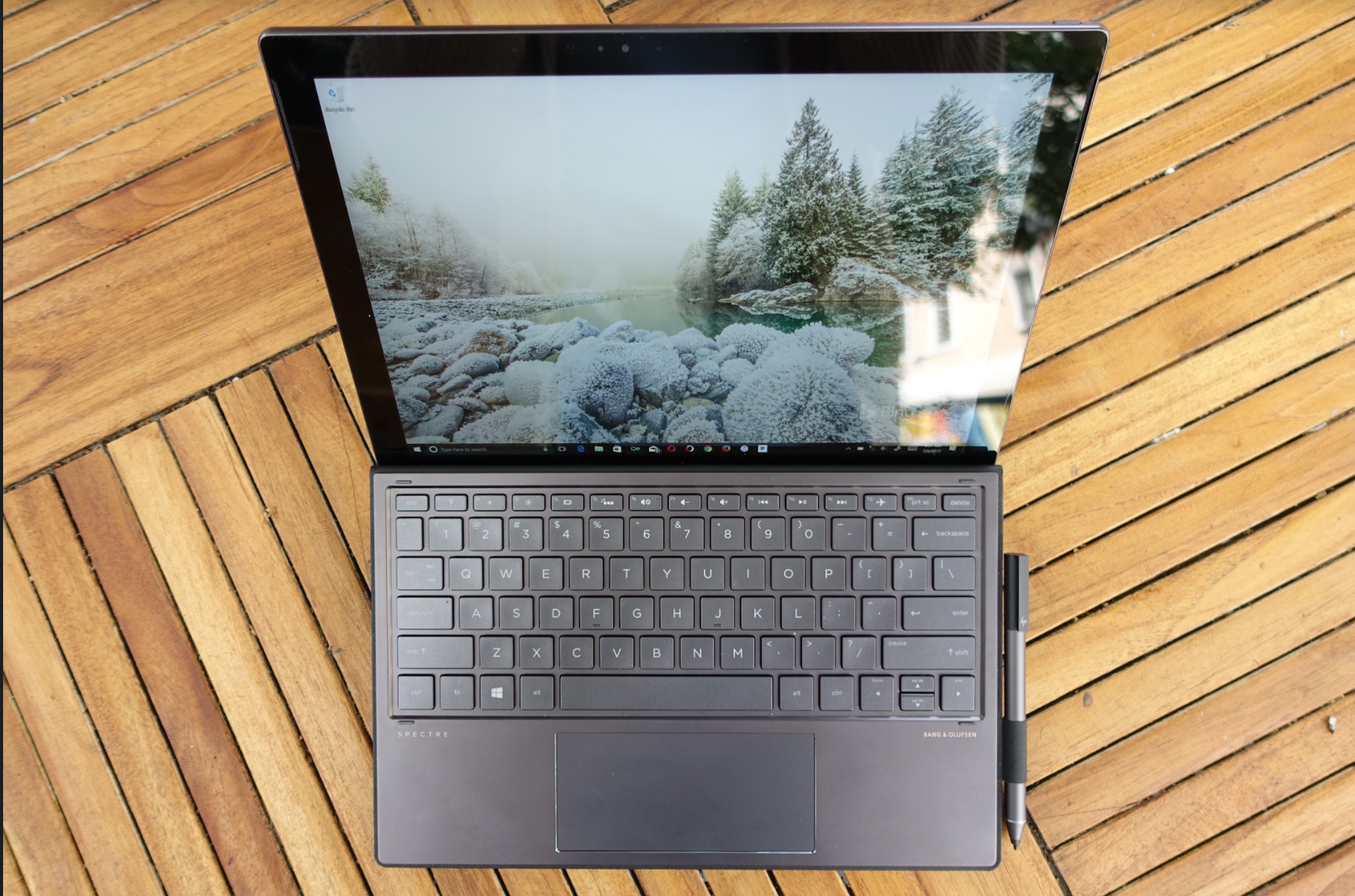
Cloaked in HP’s now signature Ash Silver colorway that’s part of the Spectre line along with copper metal accents, the Spectre x2 this year feels more like a piece of contemporary desk art with retro mid-century modern styling. This makes the Spectre x2 look more noticeable on a desk compared to its more utilitarian Surface Pro counterpart, and HP’s design elevates the look of this tech-filled PC into something you won’t want to stow away when you’re not using it.
The design of the Spectre x2 is very reminiscent of Microsoft’s Surface Pro and competitors in the detachable space, like Lenovo’s Miix 720. All the PC components—processor, RAM, storage and battery—are housed in the tablet component. And to transform this slate into a laptop, a detachable keyboard snaps into place via magnets on the bottom. Unlike the Surface Pro, the keyboard and the active digitizing pen are included in the box so you won’t need to spend extra for these accessories.
Because the detachable form factor is the preferred computing design for road warriors, HP made the Spectre x2 lighter and thinner this year. The tablet is just 7.7mm thick and weighs just 1.68 pounds, making it four percent thinner, six percent lighter than last year’s model, and both thinner and lighter than the 2017 Surface Pro. With the keyboard, the Spectre x2’s 2.49-pound weight is still well under the Ultrabook specifications.
To make the Spectre x2 unique, HP added its own custom touch to the detachable design. For one, rather than a solid metal slab for the kickstand—like on the Miix 720 and Surface Pro—HP went with a sculpted U-shaped bar. The U-shaped kickstand is made up of stainless steel to give it structural integrity, and HP added its own Midas touch by coating the metal with copper, and the golden result looks very luxurious. From a functional perspective, going with the U-shaped design saves space, explained Mike Nash, chief technologist for personal systems and global head of customer experience and portfolio strategy at HP, in a conference call.
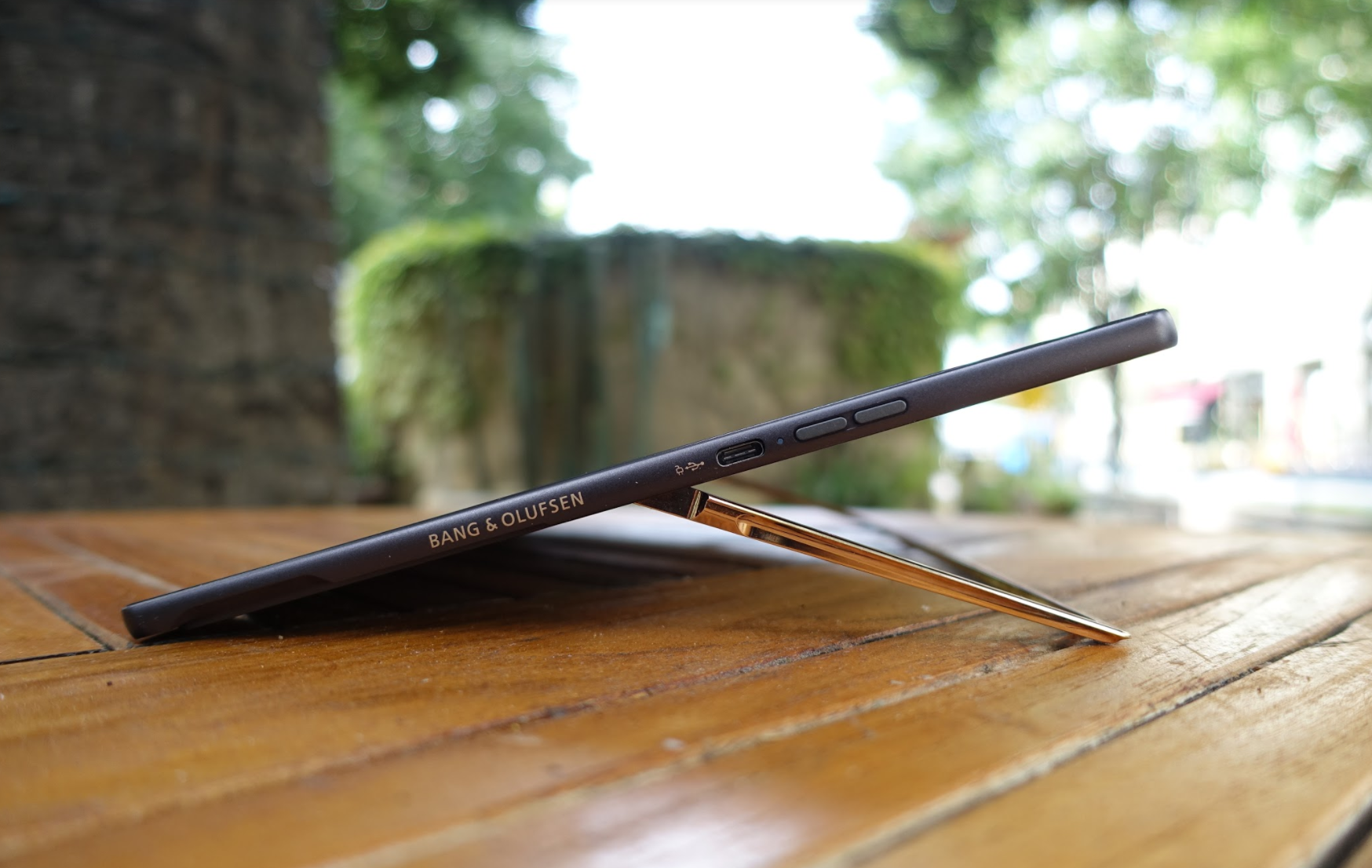
The U-shaped kickstand opens up to 165 degrees this year, and the accompanying hinge is very sturdy. When extended and used with the bundled HP Active Pen, the tablet didn’t shake as much when you’re drawing on the screen, compared to Microsoft’s Surface Pro. This year, HP refined the design and did away with a release latch from last year’s model, making it easier to engage the kickstand. Notches on either side of the tablet helps you pull out the kickstand. While the kickstand is easier to engage than last year’s model, I found that the friction from the hinge and a magnetic latch makes it difficult to pull out the kickstand.
The keyboard is another area where HP made improvements. Unlike the softer materials— like the Alcantara fabric on the Surface Pro or the felt material on the Miix 720 covers the outside of the keyboard, the Spectre x2 comes with a more durable imprinted polyurethane. This texture gives the cover the feel of Saffiano leather—a signature leather that was invented and popularized in Italy by luxury fashion house Prada.
When carried, the crosshatch pattern of the faux leather gives the tablet a luxurious leather portfolio feel—in this case it’s a digital portfolio rather than an analog one stuffed with a paper pad. Additionally, because it’s not a soft material, it can be more easily wiped down in the event of dirt or spills, which should readily appease germaphobes.
Ports
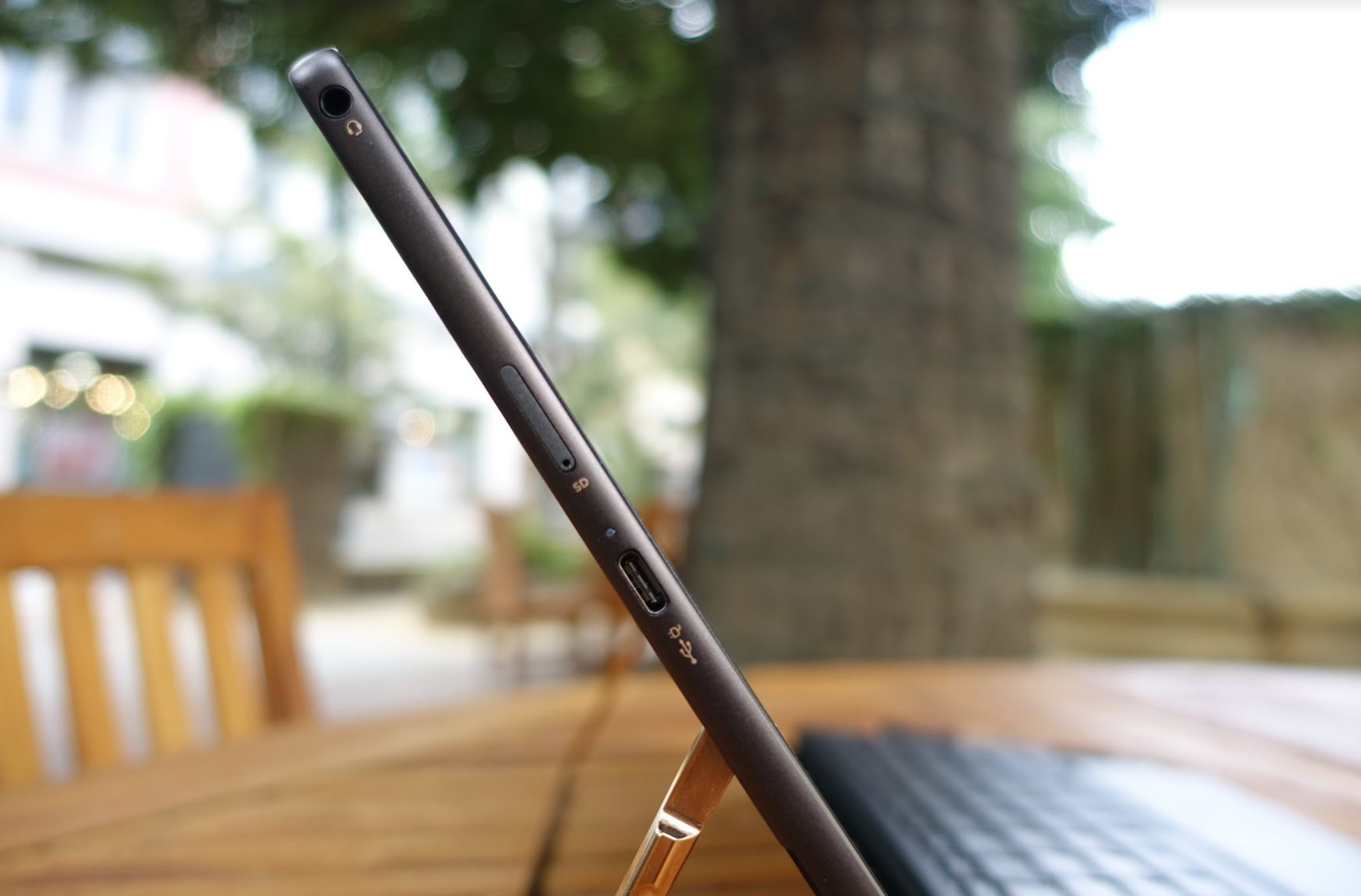
With this year’s Spectre, HP fully embraces the USB Type-C standard. On the device, you’ll find two USB Type-C ports, one on either side of the tablet, along with an audio jack. Unlike last year’s model, there’s no USB Type-A port, but the tablet ships with a USB Type-C to USB Type-A dongle in the box should you need access to legacy devices. The USB Type-C ports are capable of power, data transfers and also video output. With an optional USB Type-C to HDMI dongle, for example, the port replaces other video port standards.
It’s a bit disappointing that HP opted to go with just the USB Type-C format, which tops at 5Gbps speeds over USB 3.1 Gen 1 specs, rather than the faster Thunderbolt 3 over USB Type-C format, like Lenovo’s implementation on this year’s Miix 720 tablet. Thunderbolt 3 would allow you to use HP’s new Omen graphics dock, for example, and add discrete graphics to the Spectre x2 at your desk, transforming this tablet into an even more powerful gaming system. However, it’s hard to complain when the 2017 Surface Pro doesn’t even have USB Type-C ports.
Nash said that users with more robust computing needs can turn to HP’s enterprise lineup, including the 2017 Elite x2, for Thunderbolt 3 support. However, this seems to be a cop out explanation, given that HP’s Spectre x360, a consumer convertible, supports Thunderbolt 3 over USB Type-C, while the x2, with its more limited ports, doesn’t.
There is also a microSD card slot located on the left edge of the tablet, but that port is a bit inconvenient to access when traveling since you’ll need a pin to pop the port open. I much prefer the Surface Pro’s concealed microSD card slot, located just behind the kickstand, that can be pushed to insert or remove.
Display & Speakers
For pixel peepers, one area where the Spectre wins big over the competing Surface Pro is the display. Both tablets support a 3:2 aspect ratio screen, which makes them more ideal for multitasking, and viewing documents than for media consumption. However, the Spectre x2 comes with a higher resolution 3,000 × 2,000-pixel 12.3-inch screen, matching the display of the more premium Surface Book. On the other hand, the Surface Pro’s screen clocks in at 2,736 × 1,824 pixels.
The screen is also brighter than the Surface Pro. Whereas most tablets suffer from readability issues outdoors, at 450nits, the Spectre x2 can readily be used outside without issue. Indoors, I found myself frequently adjusting the screen brightness down. HP claims the display has a 72 percent color gamut, which is the sweet spot for balancing battery consumption and giving the screen optimal white balance. Any lower, Nash explained, and the whites on the display would look yellowish.
Compared to the 2016 model, the 2017 Spectre x2 is also more compact thanks to bezel improvements around the display. Unlike the nearly bezel-less frame on the convertible Spectre x360, bezels are still required on the x2 to make the device usable as a tablet given its form factor. This year, the bezels have decreased by approximately 22 percent, making the device compact, but still easily grippable in tablet mode.
This year, HP changed its audio implementation for the Spectre x2, going with front-firing speakers with a discrete amp. Audio coming from the Spectre x2 sounds balanced and the tuning is very neutral given the partnership with Bang & Olufsen. There is sufficient left- and right-channel isolation for stereo sound output, and I didn’t notice much distortion even at higher volume settings.
Specifications
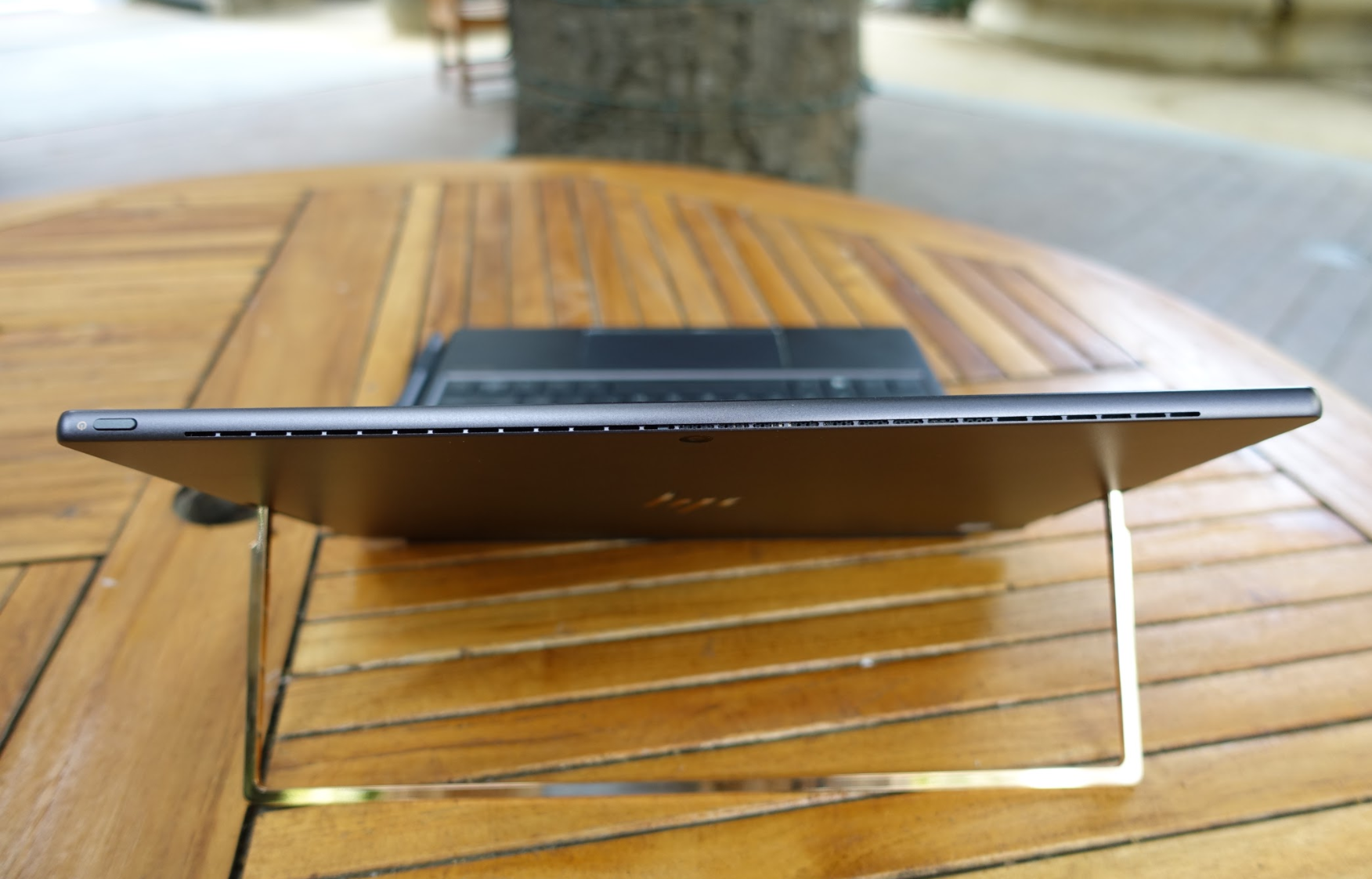
The base configuration of the Spectre x2 with an Intel 7th Generation Kaby Lake Core i5 CPU starts at $1,149, with HP offering varying configurations for CPU, storage and RAM options. Enhanced Intel Iris Plus integrated graphics is standard across all configurations, unlike the Microsoft Surface Pro.
Our review unit comes with an upgraded Intel Core i7 processor alongside 8GB RAM, 360GB SSD, and this is the standard SKU that will be carried by many retailers. As configured, our configuration comes to $1,299 with the pen and keyboard included. A top-of-the-line configuration sold through HP’s web store with a Core i7 processor, 16GB RAM and 1TB SSD will cost $1,969.
Given that the pen and keyboard folio are included in the box across all models, the Spectre x2’s pricing makes it a more affordable alternative to Microsoft’s hardware. For comparison, my Surface Pro review unit, priced similarly at $1,299, comes with just a Core i5 processor and more limited 256GB SSD. The Surface Pro keyboard cover adds another $159 to the price, and Microsoft’s Surface Pen comes in at an additional $99, giving the package a total value of $1,557.
Benchmarks
Even though our Kaby Lake Core i7-powered Spectre x2 with integrated Intel Iris Plus graphics performed well, benchmarked results were mixed using PCMark 10, PCMark 8, 3DMark and Cinebench tests.
Running the Home Conventional Test on the PCMark 8 suite, the Spectre x2 score 2,378 points. On the newer PCMark 10 benchmark, the Spectre x2 scored 3,503 points. It also scored 318 points on 3DMark’s Time Spy test, and 25.51fps using Cinebench R15. For comparison, despite having a Core i5 processor and weaker integrated Intel HD Graphics, our Surface Pro performed better under the Time Spy benchmark, earning 345 points, and the 2,204 points from the PCMark 8 test is within close range of the Spectre x2’s results.
For most users, the benchmark results shouldn’t matter much, as performance of the Spectre x2 is very fast. HP did preload the Spectre x2 with Intel’s McAfee security suite, which slowed down system performance and hogged resources in the background. With the software removed, performance greatly improves and I didn’t notice any lags or slow downs.
For a full comparison on how the Spectre x2 measures against its contemporary rivals, be sure to check out our Surface Pro (2017) and Lenovo Miix 720 reviews.
Performance
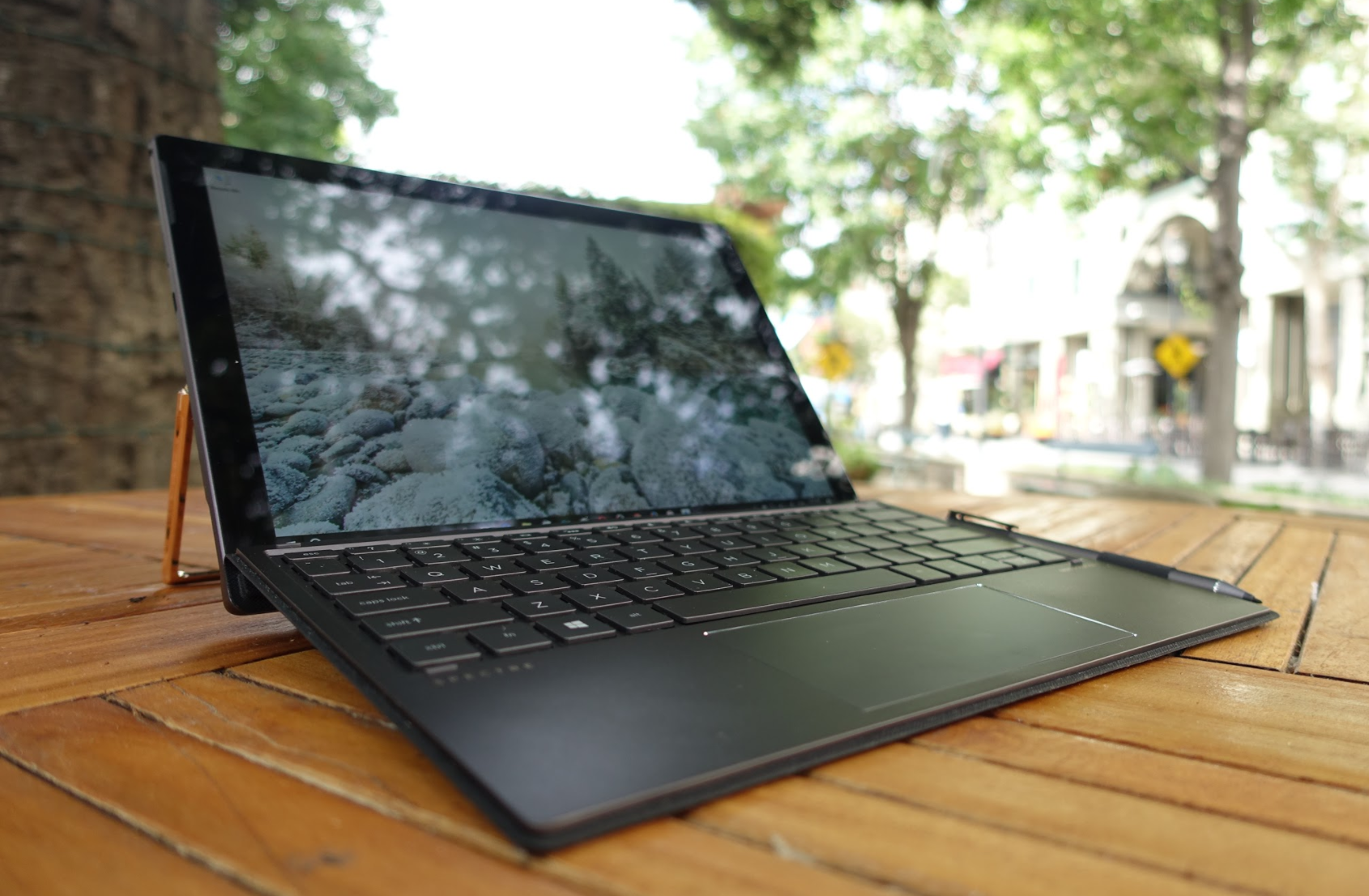
With the keyboard attached, as a laptop, the Spectre is very responsive and fast given the use of Intel’s latest dual-core Kaby Lake-series Core i7 processor. I didn’t experience any lags during my testing of the system. If you encounter any slowdowns, I would recommend either disabling or uninstalling the preloaded McAfee software.
Unlike the Surface Pro, all configurations of the Spectre x2 come with a fan. The air vent is located at the top of the tablet, and HP’s Nash claims that the fans are needed since the systems are tuned for performance. During my use, fan noise is very low and didn’t bother me at all given how quiet the system runs. For the most part, the fans do a good job of keeping the Spectre x2 cool. However, under heavy stress, the top half of the tablet gets pretty hot. I’ve only noticed heat to be an issue when I was downloading large files simultaneously, editing large photo files or working on video edits.
During peak performance, heat can make the Spectre uncomfortable to hold as a tablet, but if you’re using the device on your lap or on a tabletop, heat shouldn’t be a problem. Compared to laptops where the processor and graphics is located on the keyboard base, which can make the keyboard deck uncomfortably warm, packing the computing components into the screen solves any heat issues in laptop mode.
Like the Surface Pro, lapability can be a struggle with this design, especially if you don’t have long legs because you’ll need additional leg room to accommodate both the keyboard and the extendable kickstand on the rear in laptop mode. On an airplane, if I am not doing any work, removing the keyboard makes using the Spectre far more elegant as a tablet for consuming media than a similar iPad without a built-in kickstand.
Despite its polish and power as a tablet than can replace your laptop when traveling, the Spectre x2 suffers a bit when it comes to tablet functionality. This isn’t a problem that’s specific to HP. Rather, it’s endemic to Windows 10 systems in general. You’ll have access to the excellent repository of programs designed for Windows, but most of the legacy software comes with small buttons that are tuned for keyboard and mouse control, rather than touch input. The number of touch optimized apps available on the Windows Store are limited.
In spite of the shortcomings of the Windows ecosystem, the Spectre x2 is a very robust machine that can handle just about anything you throw at it. Multitasking is a breeze, and for an even larger workspace, you can connect the Spectre x2 to two external displays. You can even have a more focused workflow by running multiple virtual desktops.
Like the Spectre x360, the included HP Active Pen makes use of Microsoft-owned N-Trig technology and comes with 1,024 levels of pressure sensitivity. I had no problems marking up websites with inking support built into the Microsoft Edge browser, writing in OneNote or making quick edits in Photoshop.
In comparison, Microsoft’s updated Surface Pen supports up to 4,096 levels of pressure, improved latency and comes with shading features, similar to the Apple Pencil. HP representatives were unsure if using the new Surface Pen on the Spectre x2 would bring these improvements to the company’s tablet, and I didn’t have the new Surface Pen on hand to test. In general, the Surface Pen’s basic inking features should work on the Spectre x2, and because I am not an artist—I primarily use the pen for text, I cannot comment on whether this means any perceivable degradation in inking capabilities.
Keyboard & Trackpad
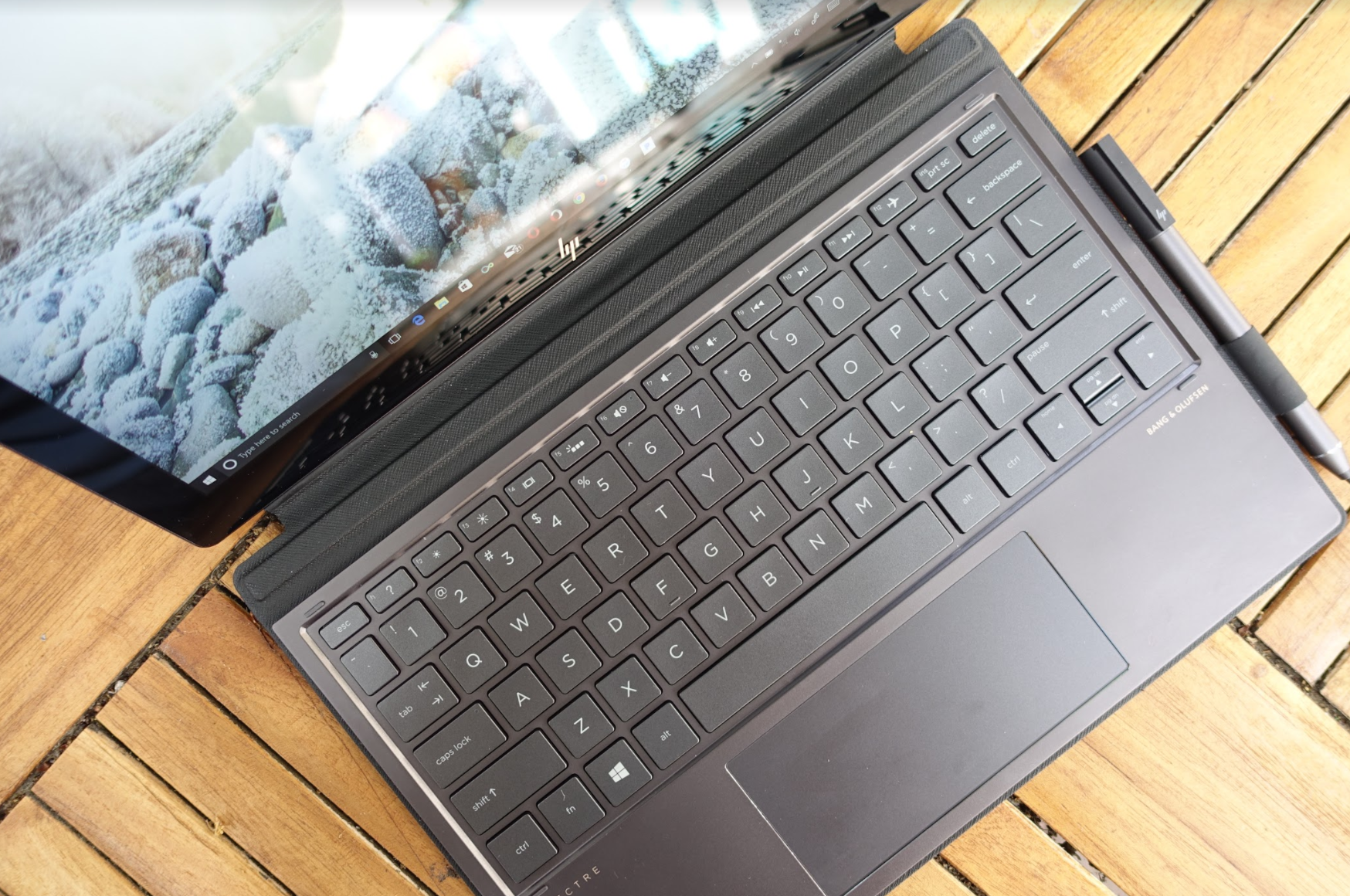
Despite its tablet-first form factor, HP didn’t skimp on the keyboard. The detachable keyboard deck is reinforced with a solid sheet of aluminum, which reduces flex and bounce when you’re typing, and the package is coated in the same Ash Silver hue as the rest of the tablet. I really appreciated the reinforced metal plate as the keyboard feels sturdier than the Surface Pro’s Signature Type Cover. Strong magnets hold the keyboard in place, and a second set of magnets allows you to wrap the keyboard up front and attach it to the bottom glass edge of the screen, raising the keyboard for better typing ergonomic as well as providing a more stable position for using the Spectre x2 as a laptop on your lap.
The keyboard deck utilizes full-sized backlit keys with an island-style arrangement, similar to the excellently rated keyboard experience on the convertible Spectre x360 from this year. The backlight is not adjustable and can only be toggled on and off—I wish you can adjust the brightness here. Key travel is very comfortable, and the keys are very responsive and clicky without being overly loud, like on Apple’s recent MacBook and MacBook Pro keyboard implementations. I find key travel to be on par with the 13-inch Spectre x360— the 15-inch HP Spectre x360 has deeper keys.
And just below the keyboard is a very wide trackpad, which provides plenty of surface to mouse around on. The trackpad is an HP-optimized Synaptics component and the Spectre x2, unlike the Miix 720 and Microsoft’s Surface family, doesn’t utilize the Microsoft Precision TouchPad drivers. I didn’t have any problems with tracking accuracy or sensitivity, and the only negative I can find with the Synaptics implementation is that you’ll need to fine-tune your settings and setup touchpad gestures through the Synaptics app, rather than the default Windows 10 settings.
My minor nitpick with the keyboard is that the metal reinforced plate doesn’t extend all the way to edge of the keyboard deck. From a design perspective, this implementation allows a slight border from the beautiful faux Saffiano leather cover used on the outer surface of the folio to show through when the keyboard is used, but this means that you have a slightly squishy edge, which feels less premium when you’re carrying the Spectre x2, compared to a more flush and rigid keyboard folio edge like that on Samsung’s Galaxy Book. The Galaxy Book, by comparison, however, has a less premium plastic cover and could benefit from the Saffiano-like treatment from HP’s Spectre x2 design.
Battery Life
Battery life is mixed when using the Spectre x2. Even without relying on benchmarked battery life and anecdotal real-world usage, HP’s stated battery life number is short of what Microsoft’s claims for the competing Surface Pro. HP claims that the Spectre x2 is capable of achieving nine hours of use on a charge.
Running PCMark 8’s Home Conventional benchmark, the Spectre x2 received a battery life score of just two hours and 32 minutes. In reality, my mixed use of working with office tasks—web browsing, viewing documents and PDFs, light photo editing and working on Google Docs within the browser—notched approximately four hours of battery life. Fortunately, to compensate for its middling battery performance, the Spectre x2 is able to recharge very quickly, benefiting from the same HP rapid charging capabilities that’s found on the Spectre x360. With Fast Charge, you’ll be able to get 50 percent of your battery charged in thirty minutes, so a quick lunch time top-off should get you through a work day.
There are a few explanations for the difference in battery performance between the Spectre and the Surface Pro. One, our Surface Pro review unit was a Core i5 model, compared to the Spectre’s more powerful Core i7 processor. Second, the Core i5 Surface Pro was fanless, leading to better battery performance as energy isn’t required to spin the fans, whereas our performance-driven Core i7 Spectre x2 is powered by quiet fans. And third, the Spectre x2 comes with a much higher resolution display that’s brighter than the Surface Pro’s panel, requiring more power.
Our Spectre x2 review unit was pre-loaded with McAfee’s security suite, which affected battery and system performance. Disabling McAffee helps, and we saw a jump in battery performance to just over five hours when the antivirus suite was uninstalled.
Verdict

While the Spectre x2 borrows the iconic Surface Pro form factor, HP added its own design flourishes to make the Spectre a uniquely luxurious alternative to Microsoft’s category-defining detachable. A unibody frame, mid-century-like modern design, attractive Ash Silver paint coat, Midas-like copper accent and a rich Saffiano faux leather folio gives the Spectre x2 a level of sophistication and elegance that’s largely unrivaled in the tech space. If you’re in the market for a detachable or shopping for a Surface Pro, the Spectre x2 should be on the top of your list.
And the Spectre x2 is as smart as it looks. Balancing beauty and brawns, the Spectre x2 packs in high-end specs, such as Intel’s 7th Generation Kaby Lake Core i7 processors and integrated Intel Iris Plus graphics, giving it uncompromised performance in a largely mobile form factor. You can use the Spectre x2 is a tablet, as a laptop with the included keyboard folio attached or as a desktop with an optional USB Type-C desktop dock. And unlike the Surface Pro that it competes against, the Spectre x2 comes with the keyboard and pen, adding value to your purchase.
There are small things that HP can improve on for its next generation of Spectre x2, like better battery performance and support for Thunderbolt 3 over the USB Type-C ports. And while the keyboard folio is excellent, I’d love to see HP experiment with more colors for the leather-like exterior surface for even more personalization. As it stands, there’s plenty to love with this form factor—a bright and high resolution screen makes this tablet an appealing choice for artists, a thoughtfully designed keyboard delivers an excellent typing experience, the quick charge technology is a great feature for road warriors and students, and the bundled pen works well for doodling, drawing and note-taking.